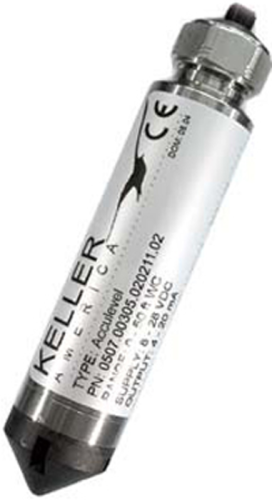This product is not available for new orders.

| Services Available |
|---|
Overview
The CS460, manufactured by Keller America, is a submersible pressure transducer for water level measurements in canals, wells, ponds, harbors, lakes, streams and tanks. It has several output options, allowing all of our dataloggers to measure it.
Read MoreBenefits and Features
- Fully temperature-compensated
- Compatible with most Campbell Scientific data loggers
Images

Detailed Description
The CS460 measures water level with an accuracy of 0.1% FSR. Its pressure range is designated at time of order. This transducer uses a strain gage bonded to a pressure-sensitive diaphragm. Electrical resistance changes as pressure changes on the diaphragm. The data logger records the pressure measurement, and then converts the measurement to water level.
The CS460 has a rugged Hytrel cable that remains flexible, even under harsh environmental conditions. The cable incorporates a vent tube to compensate for atmospheric pressure fluctuations. The vent tube terminates inside a desiccant tube, which prevents water vapor from entering the inner cavity of the transducer.
Compatibility
Note: The following shows notable compatibility information. It is not a comprehensive list of all compatible or incompatible products.
Dataloggers
| Product | Compatible | Note |
|---|---|---|
| 21X (retired) | ||
| CR10 (retired) | ||
| CR1000 (retired) | ||
| CR10X (retired) | ||
| CR200X (retired) | ||
| CR206X (retired) | ||
| CR211X (retired) | ||
| CR216X (retired) | ||
| CR23X (retired) | ||
| CR295X (retired) | ||
| CR3000 (retired) | ||
| CR500 (retired) | ||
| CR5000 (retired) | ||
| CR510 (retired) | ||
| CR6 | ||
| CR800 (retired) | ||
| CR850 (retired) | ||
| CR9000 (retired) | ||
| CR9000X (retired) |
Specifications
| Accuracy |
±0.25 or ±0.1% FS T.E.B. Total Error Band (TEB) includes the combined effects of non-linearity, hysteresis and non-repeatability, as well as thermal dependencies, over the compensated temperature range, expressed as a percentage of the Basic Range. All intermediate ranges are realized by deranging from standard basic ranges of 30, 100, 300, and 900 ft WC. |
| Pressure Output | 0 to 2.5 Vdc; 0 to 5 Vdc; 0 to 10 Vdc; 4 to 20 mA |
| Wetted Materials | 316L stainless steel, polyamide, fluorocarbon |
| Operating Temperature Range | -10° to +80°C (compensated) |
| Temperature Output | RS-485 |
| Supply Voltage | 8 to 28 Vdc |
| Current Drain | 3 mA (continuous) |
| Diameter | 2.1 cm (0.825 in.) |
| Length | 10.9 cm (4.3 in.) |
Frequently Asked Questions
Number of FAQs related to CS460-L: 6
Expand AllCollapse All
-
The CS460-L has several output options:
- 0 to 2.5 Vdc
- 0 to 5 Vdc
- 0 to 10 Vdc
- 4 to 20 mA
-
Yes, and because of this, it is critical to keep the vent tube free of condensation.
-
There are a couple advantages to using a sensor with a 4 to 20 mA output. Because current measurements can travel longer distances than voltage measurements, it is possible to use cable lengths that are thousands of feet. Second, because the sensor produces 4 mA when the sensor is reading zero pressure, it is possible to discern that the sensor is still operational when the reading is zero.
-
Yes. The CURS100 was made specifically for this purpose and can be used with the CR800, CR850, CR1000, and CR3000. In addition, the same 100 ohm precision resistor, usable with all Campbell Scientific data loggers, is contained in pn 7977, 100 Ohm Shunt Resistor Assembly, 3.25 inch Cable.
-
Place a 100 ohm precision resistor across the signal and ground lines of the CS460-L. The data logger will be able to read the voltage drop across the resistor, which will be in direct proportion to the milliamp reading.
-
These sensors consume a lot of power compared with other sensors. A sensor with a 4 to 20 mA output will consume at a minimum 4 mA, and as much as 20 mA at full scale. This must be accounted for in a system’s power budget. To conserve power, consider using the SW12V port on the data logger to turn the sensor off between measurements.
In addition, Campbell Scientific data loggers cannot measure a 4 to 20 mA signal directly and require the use of a 100 ohm precision resistor, such as a CURS100, to measure the sensor.

